Last Updated on April 8, 2025 by Kittredge Cherry
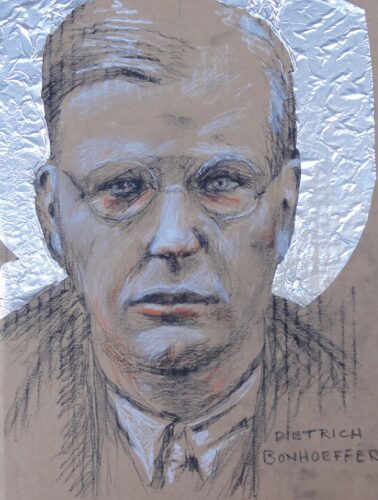
Influential German theologian Dietrich Bonhoeffer was an anti-Nazi dissident whom a few scholars believe experienced same-sex attraction. Speculation about his likely gay orientation focuses on his love for Eberhard Bethge, who was his best friend and biographer.
Bonhoeffer is honored as a saint, martyr and theologian on the anniversary of his death (April 9) by the Lutheran, Episcopal and Methodist churches.
The possibility of a gay Bonhoeffer is especially significant because conservatives use him as a role model for government resistance in their opposition to marriage equality. His own psychological struggle with homosexual attraction may help explain how Bonhoeffer, a person of privilege, became such a strong ally of the oppressed.
Brave and brilliant, Bonhoeffer is widely acknowledged as one of the most influential theologians of the 20th century. Revered by both the secular Left and the religious Right, he was executed by the Nazis for opposing Hitler.
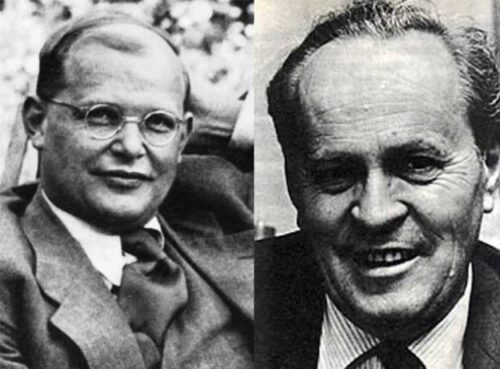
Dietrich Bonhoeffer, left, and Eberhard Bethge
“Bonhoeffer’s relationship with Bethge had always strained toward the achievement of a romantic love” while remaining “ever chaste,” writes religion professor Charles Marsh in “Strange Glory: A Life of Dietrich Bonhoeffer.”
The 2014 biography provides a detailed examination of the love between the two men, who were both theologians in the Nazi resistance. The book cites much evidence of their close friendship: They shared a joint bank account, gave gifts together and sent Christmas cards signed, “Dietrich and Eberhard.” The pair played piano together at all hours, read books aloud to each other, planned elaborate vacations together, attended church together and slept together near the fire. In his will, Bonhoeffer bequeathed Bethge his money, car, music, clothing and books, while granting his female fiance only a memento of her choice from his belongings.
Bonhoeffer never acknowledged his sexual desire for Bethge, so his life may at first appear to be an unlikely source of inspiration for LBGTQ people, but as he himself said, “There is meaning in every journey that is unknown to the traveler.”
His actual theology is complex, inspiring all sides without falling neatly into any of today’s political categories. His work helped motivate liberation movements, including the U.S. Civil Rights movement, the South African anti-Apartheid movement and the anti-communist democratic movement of Eastern Europe.
Bonhoeffer is also popular with evangelical conservatives, who identify with his theology of resisting immoral government. When the U.S. Supreme Court legalized same-sex marriage in 2015, many conservatives called it a “Bonhoeffer moment” that required civil disobedience.
Bonhoeffer and Bethge became friends in their 20s
Dietrich Bonhoeffer (Feb. 4, 1906 – April 9, 1945) was born in the Prussian city of Breslau and grew up in a prominent upper middle-class German family of scientists and doctors. They had a humanistic outlook and discouraged him from studying theology, but he did it anyway. His theological education included studying under Reinhold Niebuhr at Union Theological Seminary in New York City, where Bonhoeffer also got involved in the African American church community.
Serving as a Lutheran pastor in Germany between World War I and World War II, he denounced Nazi antisemitism as heresy and called on the church to defend victims of state violence. (Some still accuse him of expressing the anti-Jewish bias of Christian tradition.)
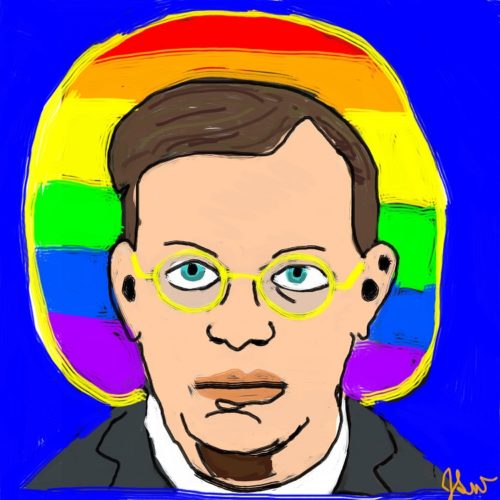
Dietrich Bonhoeffer appears with a rainbow halo in a 2022 portrait by queer iconographer Jeremy Whitner.
Eberhard Bethge (Aug. 28, 1909 – March 18, 2000), the slim, gentle son of a minister, was three years younger than Bonhoeffer. He described himself as “a country boy” from the province of Saxony. The two men met and quickly became friends in 1935 when Bethge was a student in Bonhoeffer’s first class at an underground anti-Nazi seminary in a place called Finkenwalde.

A popular Bonhoeffer mug proclaims, “Resist.” It is available on Etsy from Drinklings Coffee Mugs.
“Bonhoeffer also was in love with Eberhard, and wanted in some fashion to secure a spiritual marriage of sorts, and Eberhard could not and did not want to finally accept that,” Marsh explained in an interview with Religion and Politics about his biography “Strange Glory.”
Bethge himself commented on the rumors of his same-sex love affair with Bonhoeffer in comments quoted by Ferdinand Schlingensiepen in the essay “Making Assumptions About Dietrich: How Bonhoeffer was Made Fit for America.” He quotes Bethge’s remarks on a student conference in 1957-58 where he was asked about the intimacy of his correspondence with Bonhoeffer.
“It was felt that the correspondence must have been between homosexuals. Otherwise such an intensive correspondence was hardly imaginable. No, we were all quite ordinary. We know today that no same-sex friendship is without varying degrees of homoeroticism,” Bethge explained.
Their friendship is also detailed, with less speculation about its homoerotic character, in the biography “Daring, Trusting Spirit: Bonhoeffer’s Friend Eberhard Bethge” by John W. de Gruchy. The cover features a rare photo of the two soulmates together.
Bonhoeffer did get engaged to a mysterious woman named Maria von Wedemeyer, but scholars such as Marsh dismiss it as an effort to remain close to Bethge, who had just gotten engaged to Bonhoeffer’s niece. His oddly distant relationship with his fiancé is examined in the 2016 book “The Doubled Life of Dietrich Bonhoeffer: Women, Sexuality, and Nazi Germany” by Diane Reynolds.
Another book that discusses the friendship between Bonhoeffer and Bethge is “Spiritual Friendship: Finding Love in the Church as a Celibate Gay Christian” by Wesley Hill.
The 2022 play “Bonhoeffer: Final Days” includes more than an implication of the homosexual relationship/intimacy between Bonhoeffer and Bethge. It ran at the Producers’ Club, Prince Theater, an off-off-Broadway playhouse in New York City. The play was written by author/artist Tom Romano and stars his brother Frank Romano as Bonhoeffer.
Bonhoeffer criticized “cheap grace”
The Gestapo closed Bonhoeffer’s illegal seminary in 1937, the same year that he published his best-known book, “The Cost of Discipleship.” It spells out what it means to follow Christ in the modern world with dangerously immoral government.
 The classic book opens with the words, “Cheap grace is the mortal enemy of our church. Our struggle today is for costly grace.” Bonhoeffer’s thoughts on “cheap grace” are eloquent and often quoted. Recent scholarship shows that he borrowed the term “cheap grace” from Adam Clayton Powell, Sr., then-pastor of Abyssinian Baptist Church in Harlem where Bonhoeffer worshipped and taught Sunday school during his studies at Union seminary.
The classic book opens with the words, “Cheap grace is the mortal enemy of our church. Our struggle today is for costly grace.” Bonhoeffer’s thoughts on “cheap grace” are eloquent and often quoted. Recent scholarship shows that he borrowed the term “cheap grace” from Adam Clayton Powell, Sr., then-pastor of Abyssinian Baptist Church in Harlem where Bonhoeffer worshipped and taught Sunday school during his studies at Union seminary.
A representative selection of all Bonhoeffer’s theological works is available in “The Bonhoeffer Reader,” edited by Clifford J. Green and Michael P. DeJonge. The single volume has highlights from the massive 16-volume “Dietrich Bonhoeffer Works English Edition.”
Bonhoeffer practiced what he preached, and his anti-Nazi activities eventually led to his imprisonment. Social justice iconographer Lewis Williams portrays him during the year and a half that he spent in prison. During that time he wrote many letters to Bethge, including one in which he writes the famous line, “God is the Beyond in our midst.”
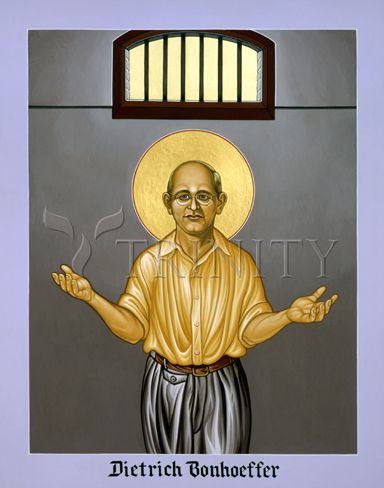
“Dietrich Bonhoeffer” by Lewis Williams. Prints are available at Amazon and Trinity Stores.
Bonhoeffer was accused of participating in a plot to assassinate Hitler and the Nazis executed him by hanging in the Flossenburg concentration camp on April 9, 1945. He died soon after his 39th birthday, less than a month before the Allies liberated the camp.
His dear friend Bethge was also imprisoned for his role in the Hitler assassination attempt, but he was rescued by the Soviet army shortly before his trial.
Bonhoeffer’s legacy continues
 Bethge lived on to spend the next 50 years preserving and promoting Bonhoeffer’s legacy. Bethge collected and edited Bonhoeffer’s “Letters and Papers from Prison” (which were mostly addressed to him) and wrote the definitive biography “Dietrich Bonhoeffer.” His long life included service as a pastor and teacher, and marriage and children with Bonhoeffer’s niece Renate.
Bethge lived on to spend the next 50 years preserving and promoting Bonhoeffer’s legacy. Bethge collected and edited Bonhoeffer’s “Letters and Papers from Prison” (which were mostly addressed to him) and wrote the definitive biography “Dietrich Bonhoeffer.” His long life included service as a pastor and teacher, and marriage and children with Bonhoeffer’s niece Renate.
Bonhoeffer is one of ten 20th-century martyrs commemorated in statues above the Great West Door at Westminster Abbey in London. A recent icon of him with a halo was sketched by Tobias Haller, an iconographer, author, composer, and retired vicar of Saint James Episcopal Church in the Bronx. He uses conte crayon on cardboard with an aluminum foil halo to evoke the unpretentious vigor of the theologian. Haller enjoys expanding the diversity of icons available by creating icons of LGBTQ people and other progressive holy figures as well as traditional saints.
Haller is expanding the diversity of icons available by creating icons of LGBTQ people and other progressive holy figures as well as traditional saints. He is the author of “Reasonable and Holy: Engaging Same-Sexuality.” Haller enjoys expanding the diversity of icons available by creating icons of LGBTQ people and other progressive holy figures as well as traditional saints. He and his spouse were united in a church wedding more than 30 years ago and a civil ceremony after same-sex marriage became legal in New York.
The German theologian’s story is also told in many books and in films such as “Bonhoeffer: Agent of Grace” and “Bonhoeffer: Memories and Perspectives.”
On Bonhoeffer’s feast day, the Episcopal church offers this prayer:
Gracious God, the Beyond in the midst of our life, you gave grace to your servant Dietrich Bonhoeffer to know and to teach the truth as it is in Jesus Christ, and to bear the cost of following him: Grant that we, strengthened by his teaching and example, may receive your word and embrace its call with an undivided heart.
Quotes from Bonhoeffer
Bonhoeffer’s own words live on, including these popular quotes whose relevance remains:
“Silence in the face of evil is itself evil: God will not hold us guiltless. Not to speak is to speak. Not to act is to act.”
“We must be ready to allow ourselves to be interrupted by God.”
“We are not to simply bandage the wounds of victims beneath the wheels of injustice, we are to drive a spoke into the wheel itself.”
“To endure the cross is not tragedy; it is the suffering which is the fruit of an exclusive allegiance to Jesus Christ.”
“God does not love some ideal person, but rather human beings just as we are, not some ideal world, but rather the real world.”
“There is no way to peace along the way to safety. For peace must be dared. It is the great venture.”
“The essence of optimism is that it takes no account of the present, but it is a source of inspiration, of vitality and hope where others have resigned; it enables a man to hold his head high, to claim the future for himself and not to abandon it to his enemy.”
___
Related links:
Queer theology in Nazi Germany: Dietrich Bonhoeffer pointed the way (medium.com)
Gebet zum Christus des Regenbogens (Rainbow Christ Prayer in German)
___
Top image: “Dietrich Bonhoeffer” by Tobias Haller
___
This post is part of the LGBTQ Saints series by Kittredge Cherry. Traditional and alternative saints, people in the Bible, LGBTQ martyrs, authors, theologians, religious leaders, artists, deities and other figures of special interest to lesbian, gay, bisexual and transgender and queer (LGBTQ) people and our allies are covered.
This article was originally published on Q Spirit in April 2017, was expanded with new material over time, and was most recently updated on April 8, 2025.
Copyright © Kittredge Cherry. All rights reserved.
Qspirit.net presents the Jesus in Love Blog on LGBTQ spirituality.

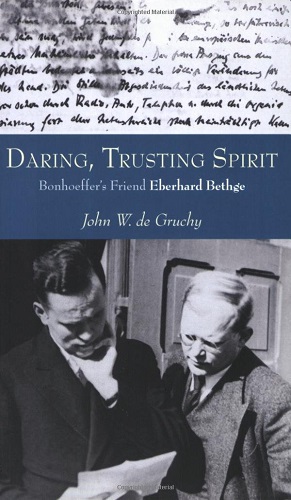




















Thank you for this article. I became a serious student of Bonhoeffer in 1950s and 60s. Bethge was invited to my Texas seminary and it was my good fortune to meet and converse with him and others regarding Bonhoeffer, whom I have always regarded as one of my mentors.
So both of them were engaged to women and Bethge bluntly denied any homosexual romance with Bonhoeffer, but you’re certain you know him better than he knew himself, right? This is like a celebrity gossip column written by someone who likes to poke their nose into other people’s private lives and speculate about what “really” is going on. You’re trying to interpret some patterns in their lives which could be explained any number of ways: e.g. Bonhoeffer’s seemingly distant relationship with his fiancee near the end of his life could easily be due to a classic lovers’ tiff of the type that so often happens in romantic relationships, which usually have their ups and downs. But in the end, only Bonhoeffer and Bethge know what “really went on”, whereas you don’t have any business in the matter.